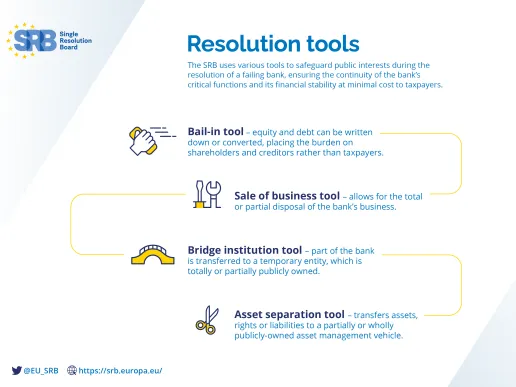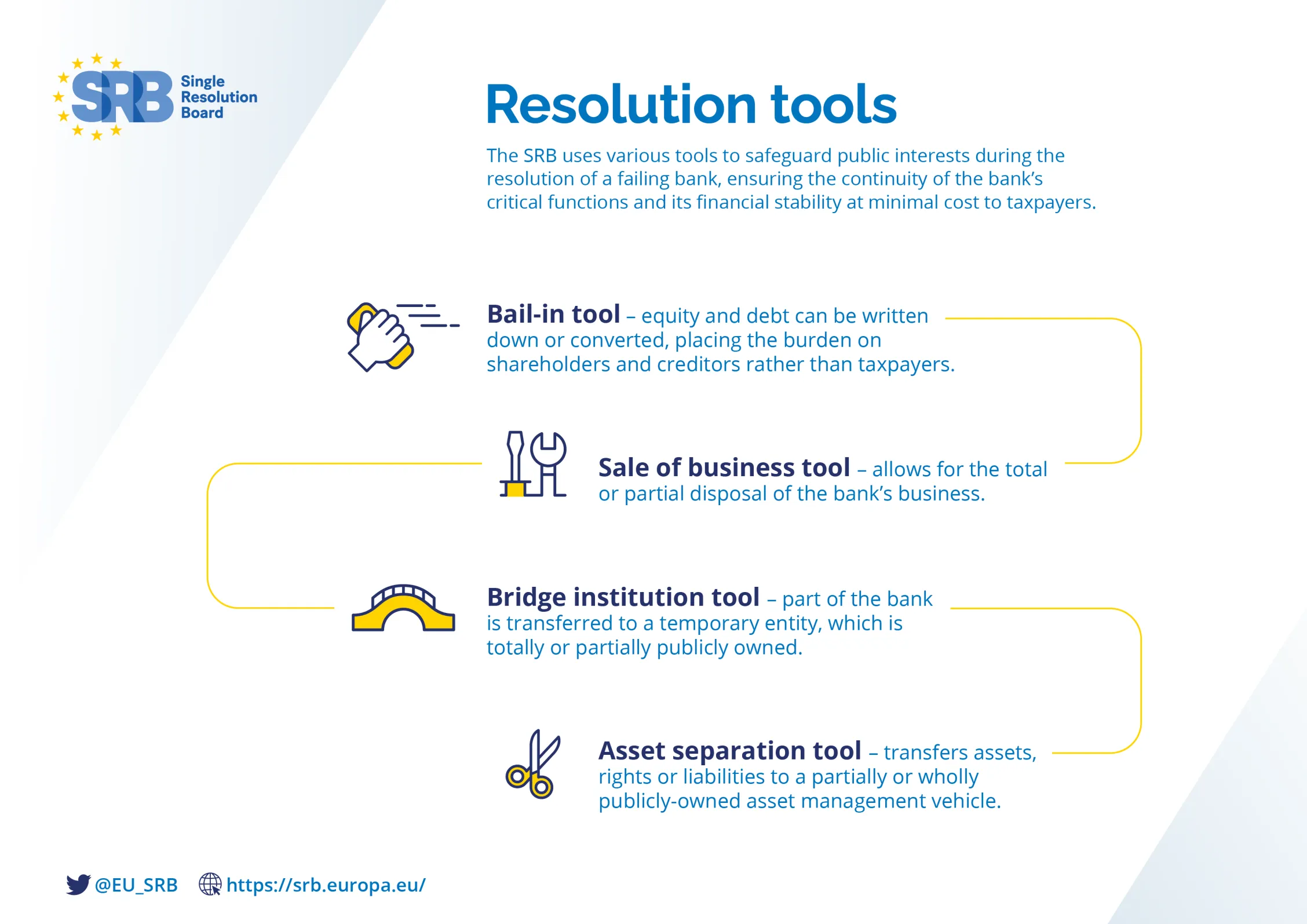Introduction
The ECB, after consulting the SRB, determines whether a bank is failing or likely to fail. However, the SRB can make such an assessment after informing the ECB of its intention and only if the ECB does not make such an assessment within three calendar days of receipt of that information. The ECB shall provide all relevant information about a bank to the SRB to help inform its assessment process. The SRB remains ultimately responsible to determine whether no alternative solution is available and whether a resolution action is necessary in the public interest.
If a bank meets the relevant conditions, the SRB places the bank under resolution. This is achieved by the adoption of a resolution scheme, which determines what resolution tools are to be applied to the bank and, if necessary, whether the SRF is to be used to support the resolution action. Before any resolution action is taken, the capital instruments of the bank must be written down or converted. The resolution tools are:
- the sale of business tool;
- the bridge institution tool;
- the asset separation tool; and
- the bail-in tool.
The relevant NRAs take the necessary steps to implement the resolution scheme.
Bail-in vs bail-outs
What is the new bail-in tool?
Bail-in is a key resolution tool provided for in the Bank Recovery and Resolution Directive (BRRD). It allows to write-down debt owed by a bank to creditors or to convert it into equity.
By replicating how creditors would incur losses if the bank had gone bankrupt, it reduces the value and amount of liabilities of the failed bank. It thereby protects taxpayers from having to provide funds to cover these liabilities, while allowing for the critical functions of the bank (e.g. deposit-taking, lending, operation of payment systems) to be uninterrupted.
The bail-in tool can be used to:
- Recapitalise the institution under resolution to the extent necessary to restore its ability to comply with the conditions for its authorisation and so continue performing its authorised activities, and to sustain market confidence in the institution; or
- Convert to equity, or reduce the principal amount of, claims or debt instruments that are transferred to a bridge institution (in order to provide capital for that bridge institution) or under the sale of business tool or asset separation tool.
Bail-outs occur when outside investors, such as a government, rescue a borrower by injecting money to help make debt payments. In the past, this helped save the companies from bankruptcy, with taxpayers assuming the risks associated with their inability to repay the loans.
A bail-in, on the other hand, occurs when the borrower's creditors are forced to bear some of the burden by having a portion of their debt written off. This approach eliminates some of the risk for taxpayers by forcing other creditors to share in the pain and suffering.
Resolution authorities must ensure resolution action in accordance with following principles:
- Shareholders of the institution must bear the losses first;
- creditors of the institution bear losses after the shareholders (in accordance with the priority of their claims under normal insolvency proceedings, except where expressly provided for otherwise in the BRRD);
- Management and senior management of the institution are replaced (except where their retention is considered necessary to achieve the resolution objectives);
- Creditors of the same class are treated in an equitable manner (except where otherwise provided);
- No creditor shall incur greater losses than they would have incurred under normal insolvency proceedings; and
- Covered deposits are fully protected by the respective Deposit Guarantee Schemes.
Sale of business
What is the sale of business tool?
The sale of business tool enables resolution authorities (RA) to transfer shares or other instruments of ownership issued by an institution under resolution, and all or any assets, rights or liabilities of an institution under resolution to one or more purchasers that are not a bridge institution. The resolution authority has the power to do so with or without the consent of shareholders. The sale of business tool may be applied individually or in combination with other tools. As for all resolution tools, its use must promote the resolution objectives.
What happens to the remaining entity in the event of a partial sale of business?
When the sale of business tool is used to transfer parts of assets, rights and liabilities, the residual entity shall be wound up under normal insolvency proceedings. This should be completed within a reasonable timeframe.
What happens to the entity in the event of a share transfer of business?
Share transfer provides the best tool in liquidity crisis. It aims towards a sufficient recapitalisation of the bank, through a complete acquisition of the whole bank. Share transfer is a quick and efficient solution, as it safeguards the continuous operation of the bank and access to deposit. Through a share transfer of the bank, the franchise value of the bank remains preserved.
Bridge institution
What is the bridge institution tool?
The Bridge Institution Tool aims to set up a bank that can be disposed (thus preserving the critical functions of the failing bank) and to separate it from the rest. The tool enables to transfer part or all of the shares or assets, rights and liabilities to a temporary entity. Such a temporary entity is called a Bridge Bank or: Bridge Institution (BB).
What is a Bridge Bank?
Bridge banks operate a temporary insolvent bank until a sale to a private buyer can be concluded. The bridge bank ensures the continuation of administration of the assets and liabilities of the failed bank and maintains access to all critical functions and core business lines of the failed bank, until the bank becomes solvent again —either through acquisition by another entity or through liquidation.
Who is in charge of the bridge bank?
A bridge institution is wholly or partially owned by one or more public authorities and is controlled by the RA. The bridge bank is authorized by the RA to operate the insolvent bank. Because of the supervision of the BB by the RA, the market value of the failed entity can be preserved, as it allows for a complete cleaning and restoring of the market confidence of the bank. The day-to-day management remains under the responsibility of the RA.
How long is the bridge bank tool put in place?
The sale to the private buyer must happen within two years that follow after the implementation of the tool. Any residual part of the bank that has not been sold is then wound up in an orderly manner.
Asset separation
What is the asset separation tool?
The Asset Separation Tool (AST) allows transferring assets, rights, or liabilities from a failing bank or a Bridge Bank to an Asset Management Vehicle (AMV). These are managed by the AMV with the aim to maximise their value for an eventual sale, or an orderly wind-down.
The asset separation tool must always be applied together with another resolution tool (sale of business, the bridge institution and/or bail-in).
Who will be the owner of the asset management vehicle?
The AMV is wholly or partially owned by one or more public authorities which may include the resolution authority or the resolution financing arrangements. In line with the general resolution powers of the resolution authority to take over shareholder rights, the transfer may take place without the consent of shareholders of the institution under resolution or any third party, and without complying with any procedural requirements under company or security law.
What type of assets will be transferred to the asset management vehicle?
The resolution authority may use the asset separation power to transfer assets, rights, and liabilities only in one of the following three scenarios:
- The market for those assets is such that their liquidation under normal insolvency proceedings could cause market disruption on one or more financial markets.
- The transfer is necessary to ensure the proper functioning of the institution under resolution or bridge institution.
- The transfer is necessary to maximise the liquidation proceeds.
How is the asset management vehicle funded?
The funding structure of the AMV depends on the value and characteristics of the assets transferred. If combined with the bail-in tool, the amount of bail-in has to take into account a prudent estimate of the capital needs of an AMV. Any consideration paid by the AMV in respect of the assets, rights or liabilities transferred directly from the institution under resolution may be paid in the form of debt issued by the AMV.
Moratorium
What is the moratorium tool?
Resolution authorities can use the moratorium tool to suspend any payment or delivery obligations under any contract to which an institution under resolution is a party (except for certain excluded obligations[1]). A moratorium can last no more than two business days.
Simply put, should a bank be failing or likely to fail or is placed in resolution, the SRB can “freeze” the bank for two days until a decision is reached or where there is a need for additional time to complete the planning of resolution action.
The moratorium can be applied to deposits, including eligible deposits (defined in the Deposit Guarantee Scheme Directive), subject to the resolution authority’s careful assessment of the appropriateness of extending the suspension to eligible deposits (especially to deposits covered by the deposit guarantee scheme that are held by natural persons and micro, small and medium-sized enterprises). The Bank Recovery and Resolution Directive gives Member States a national option to ensure depositors have access to an appropriate daily amount from their deposits, when the pre-resolution moratorium power is applied to eligible deposits.
There is currently no harmonised moratorium tool at EU level at the supervisory or early intervention phase, i.e. prior to the point of non-viability and placement in resolution.
When can it be used & who decides?
The power may only be used where a bank is failing or likely to fail (FOLTF) with no private sector recovery options or alternative measure that would restore it to viability. The moratorium power may also be used to make one of two assessments:
- The public interest assessment (PIA), i.e. to assess whether or not it is in the public interest to resolve the bank; or
- The determination of the resolution action or to ensure effective application of one or more resolution tools.
Resolution authorities apply the moratorium tool, after consulting the competent authorities. The decision to do so takes into account the relevant financial and economic factors and the European and national legal requirements (both European and national).
Where does the tool apply?
The tool may be applied to all financial institutions in the EU falling under the remit of the resolution authorities, where the above conditions are met. The SRB decides on the application of the tool to banks within its direct remit (i.e. significant institutions and cross-border groups).
Has the moratorium tool been used?
The moratorium tool was used for the first time in relation to Sberbank Europa AG and its Banking Union subsidiaries.
[1] Payment or delivery obligations to the following are exceptions to the moratorium: systems and operators of systems designated in accordance with the settlement finality directive; CCPs authorised in the Union and third-country CCPs recognised by ESMA, pursuant to EMIR; and central banks.

SRB Resolution tools

SRB Resolution tools